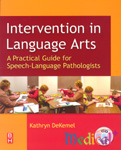This is one of the first books to examine the link between oral
language disorders and reading and writing disabilities.
Well-referenced and up-to-date coverage addresses the latest
research in this area.
The author is a licensed, certified speech-language pathologist
with over 15 years of experience in various settings, including
public schools, universities, Head Start, nursing homes, home
healthcare, and research.
Includes a chapter on long term prognosis for LLD, plus coverage
of alternative service delivery models.
Includes sample dialogues between children and therapists during
oral reading.
Offers information on how to design thematic units (a collection
of literature and related activities that explore a particular
topic), as well as sample excerpts from texts that can be used
for thematic units.
Includes a CD-ROM with forms that can be tailored, printed, and
used in practice to document progress in reading and
comprehension over time.
Forms on the CD are highlighted in the book with a CD icon, so
readers are aware of material that is on the CD.
Presents information on how to help children plan, draft,
proofread, and edit their writing.
Offers advice on deciding how long a language-impaired child
should remain in therapy and when therapy should be concluded.
Appendices include the following forms: Miscue Analysis System;
Miscue Analysis Tally Sheet; Sample typed transcript for
recording miscues; Sample factual, interpretation, and inference
questions; Question Response Scoring System; Narrative Recording
Form; Narrative Scoring Criteria; Communicative Reading
Strategies (CRS) Techniques; Story Map; and Skills/Concepts to
Target Sheet (i.e., a lesson plan)
Detailed instructions describe how to use the forms, along with
sample oral reading transcripts, responses to factual,
interpretation, and inference questions, and narrative samples
from live subjects that have already been scored.


